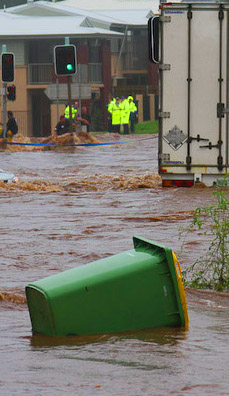Flood needs detailed
 A critical lack of federal funding is leaving Queensland with a flood warning system prone to breakdown and patchy coverage, the state’s councils have warned.
A critical lack of federal funding is leaving Queensland with a flood warning system prone to breakdown and patchy coverage, the state’s councils have warned.
A study of Queensland’s flood warning system by the Bureau of Meteorology, the Queensland Reconstruction Authority and the Local Government Association of Queensland (LGAQ) found the state was relying on an ageing patchwork of flood gauges operated and maintained by different authorities.
Councils across the state have also warned of the challenges they face trying to keep their communities safe, with hard-to-find maintenance expertise and parts as well as lightning strikes, crocodile threats and solar panel thefts from gauges leaving ratepayers vulnerable and picking up the bill.
LGAQ chief executive officer Alison Smith said the study showed the need for a properly-funded, consistently-maintained warning system.
She said the State Government committed last year to pay its share of the upgraded system and, in the wake of Queensland’s repeated floods, it is critical the Federal Government now steps up too.
“Instead of Australia’s most disaster-prone state having the best possible warning system we have one where some communities rely on weather monitors wading through dangerous floodwaters to manually read gauges so they can protect their neighbours, friends and family,” Ms Smith said.
“Councils want to be reassured that the flood warning network that helps protect their communities is fit for purpose and appropriately maintained.
On top of much-needed upgrades, the scoping study proposed 89 extra river height stations and a further 364 rainfall stations where the risk of flooding is most acute.
Cassowary Coast Regional Council Mayor Mark Nolan said his community could handle extreme tropical weather but needed an early-warning system it could rely on.
“We had an issue a couple of years back where our flood gauge on North Johnstone River failed and people woke up with a metre of water in their homes,” Mayor Nolan said.
Early warning save lives, he said.
Douglas Shire Mayor Michael Kerr said a broken gauge meant Daintree residents received little warning to prepare to be cut off by floodwaters just a fortnight ago.
Cr Kerr said the prediction was for a 6m Daintree River – the community were taken by surprise by 8m instead.
“Having those gauges are so important in tropical regions like this,” he said.
“The more information we have the better and the safer we can be.
“We had no ferry, so no access to the Daintree for two days, three days.
“We can’t plan for things if you don’t have the warnings.
“It’s so important to have as much information as possible and to plan for it.
“Once it starts flooding, our community can’t get to sandbags, they can’t get to the town so we need to give them enough warning so they can get to places to get what they need to ensure they will be safe over the period when no one can get to them.”








 Print
Print